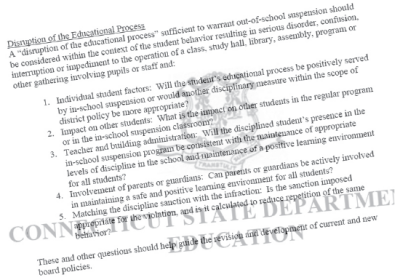
On July 1, 2009, the Connecticut State Department of Education mandated that schools aim to lower the number of students being suspended outside of school for violating district rules, but this law was quickly rescinded.
The alternative to suspending so many students outside of school would be an increase in the number of in-school suspensions.
“The state asked us to consider if the degree of the issue warranted an out of school suspension,” Assistant Principal Karyn Morgan said. “Schools needed to review [the case] and try and give an in-school suspension instead.”
Research done by the state as well as by the Connecticut Voices for Children organization showed that the “exclusion” of students from school was “neither effective nor appropriate” in most cases, unless the circumstances were drastic. Although the research supported the state’s mandate, the law had to be retracted quickly because the majority of schools in Connecticut did not actually have the funds to fulfill the requirements for in-school suspensions.
“[The law says you] need a room with full time supervision,” Morgan said. “Due to the recession [the State] could not mandate it because schools do not have the money needed to staff the rooms.”
The Connecticut State Department of Education’s Guidelines for in–School and out–of–school Suspensions emphasized that it was not trying to undermine the policies of individual schools, but that it wanted to push all schools in Connecticut to adopt better in-school suspension programs.
According to the Guidelines, “the law is not meant to take away a district’s prerogative or need to remove students from school, but rather to urge administrators to think carefully about their decisions and find ways to keep students connected to school by placing them in programs designed to keep them learning, while still holding them accountable for improper behavior.”
The idea of keeping students connected to school was appreciated by Will Muchnick ’10 who has experienced both an in-school and out-of school suspension.
“With in-school you still get to interact with students and teachers. Out-of-school is more like an abandonment than a punishment,” Muchnick said. Although the law is no longer mandated, Staples already has the monitored study room available to use for in-school suspensions. In addition, many find in-school suspension to be highly beneficial.
“Yes, there are absolutely significant benefits,” Assistant Principal Patrick Micinilio said. “Teachers can drop off work for students, and students can take exams on their regularly scheduled day. We send a note to the teachers, without giving specific details of the suspensions, and they can bring work down.”
Micinilio said that having an in-school suspension becomes more of an all day study hall, and this concurs with state’s goal of keeping kids learning while still giving them some sort of punishment.
“An in-school suspension is better because it was easier to communicate with teachers and you had a more structured work day to get your stuff done,” Muchnick said. Other students agreed that in-school suspensions were preferable, and that they were far less harsh than out-of-school suspensions.
“I wanted an in school suspension because I just felt like it’s not as severe of a punishment. Not being allowed in school just sounds so much worse than just having monitored study for two days,” Evan Gaumert ’10 said.
Although Staples will continue to be one of the schools that the Connecticut State Department of Education deems excellent in terms of “managing their districts’ suspension policies,” it can still be difficult for a wealthy district to provide a staffed in-school suspension room.
“[Monitored study] is a duty period for teachers, so there is a different teacher on duty every period. We are coming up on flu season now, and it will be difficult for me to find someone to cover,” Micinilio said.
In addition to the problem of staffing the room, there is the problem of over crowding. The monitored study room has only eight desks and one small table, and there are times in which that amount of furniture cannot accommodate all the students.
“If we are inundated with suspensions, like after homecoming, it becomes very crowded [in the monitored study room],” Mincinilio said.
Muchnick, who was in the monitored study room after homecoming, said it felt packed with the roughly 15 kids serving their in-school suspensions.
“There were so many kids that there weren’t enough desks for all of us. Teachers kept coming in looking shocked to see so many people,” Muchnick said.












































